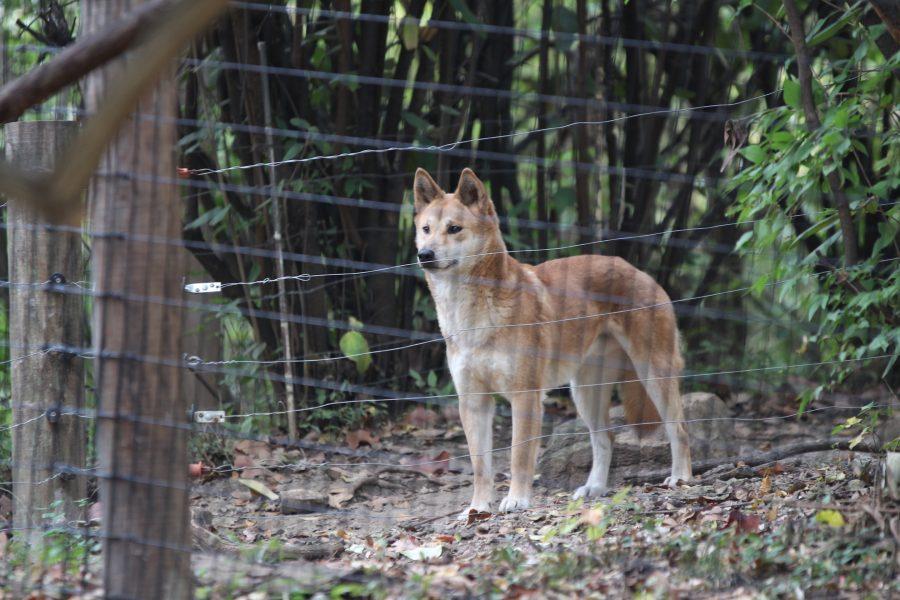What’s New At The Zoo
The Kansas City Zoo recently added koalas and dingoes, and presents a thoughtful standpoint on why keeping animals in captivity can be a good thing.
A koala, who is at the zoo on a special visit, enjoys a eucalyptus snack.
November 29, 2016
The first place comparable to a modern day zoo was established in 1500 B.C. by Queen Hatshepsut of Egypt, and since then, humans have taken the idea of keeping animals in ways that humans can easily view further and further.
There have been extreme upsides and downsides to this. People have had exhilarating experiences and animals have benefitted, attesting to the valuability of zoos, but many have also faced dangerous and fatal situations, with some going as far to say that zoos have no place in modern society.
A trip to the Kansas City Zoo, however, quickly makes one realize that it falls on the side of the spectrum that makes zoos a beneficial and greatly needed asset.
Jackson, a three year old who comes to the zoo with his grandmother, Paula, made his monthly visit to the zoo.
“I have four grandkids,” Paula said, “I think it’s important for them to see and learn about the animals.”
Another child who visited the zoo is six year old Dalton, who comes with his mom about once a year.
Each person has a special thing they like to see when they come.
Jackson’s favorite thing is, “To see the tigers,” because, “They are fast,” and Dalton’s favorite is the penguins, because, “I really like the penguins.”
Eight year old Samuel Condori’s favorite animal is also the penguins.
“Penguins are awesome. Penguins can’t fly, and I think they’re cool.” Condori said.
Meghan Newman, an interpreter at the Kansas City Zoo, whose job, drawing on her Theatre Major and Biology Minor, is to explain to the public what goes on with animals, also generally enjoys being at the zoo.
“I think that, just in general, the zoo is a really nice place. It’s not that expensive. It is a really nice place to be and just hang out- you can talk with your friends, you can see some cool stuff, that I think a lot of people overlook.” Newman said.
A new exhibit at the zoo are the koalas, which opened in April this year, and will stay until November 30.
Zookeeper Darcy Richardson explained how the koalas are cared for on a regular basis.
“It’s not as luxurious as everyone thinks. People think you get to just hug and cuddle them, but they get stressed out easily so we don’t touch them.” Richardson said.
“We only touch them to bring them outside for sunning purposes and then we weight them every single day because they show no signs of sickness, so if they are unhealthy, the only way to tell is if their weight drops.”
Richardson has a particular favorite about koalas.
“People probably wouldn’t believe this but they do actually have individual personalities. Cody is more of the skittish one and he doesn’t like human touch, whereas Burra will get down on the ground when we’re cleaning and look for food.” Richardson said.
Dingoes are also new to the Kansas City Zoo.
“They are in the canine family, but they’re not just a basic dog. They get some whole prey items and that sort of thing but then some things you do like your dog at home- like flea, tick, and heart worm prevention.” Amy Sarno, who cares for the dingoes, said.
Sarno, like Richardson, favorites the way the animals are all individuals.
“They have a lot of personality and multiple moods, and they’re very unique.” Sarno said.
The dingoes are located in the Australian realm of the zoo, and are here for the foreseeable future.
There has been controversy in the media centering around the ethics of keeping animals in captivity. Take, for instance, the killer whales at Seaworld, who were kept in stressful conditions and ended up killing trainers, and Harambe, a gorilla who was shot to protect a human child who fell into his enclosure. Many of these stories have been presented in ways that shine an intensely negative light on zoos. In October of 2016, “The Telegraph” even published an article claiming that zoos have no place in modern society.
“There’s been a lot of criticism of zoos recently and in general- and that’s always been a thing with zoos.” Said Newman.
Newman provided an intelligent and overlooked aspect to counter the criticisms on zoos.
“I think that zoos are important because they foster an emotional connection between people and animals. It makes people care about these animals, which then in turn makes them want to help by taking conservation action and becoming greener- that kind of thing.” Newman said.
The emotional connection to the animals is a uniquely important ability zoos hold to offer the public.
“It’s a place where people get to see animals they could not see out in the wild,” said Sarno, “If we didn’t have zoos people probably wouldn’t care about how many animals are being killed every day.”
Richardson explained another element that initially appears counterintuitive.
“Zoos are good. Yes, they’re here for entertainment and that’s what a lot of people think the whole purpose of a zoo is, but zoos actually exist for conservation purposes too, as we house a lot of species of animals that are endangered out in the wild. Even game parks in Africa, where people can pay to go and hunt wild and animals, do a lot of their own breeding, so there’s been instances of them actually repopulating endangered species just because people wanted to go and hunt them.” Richardson said.
The Kansas City Zoo website states that, “About 21% of the world’s mammal species, about 12% of the bird species and about 33% of all amphibian species are threatened with extinction.” But as Richardson mentioned, zoos help conservation efforts.
“A lot of endangered species have what is known as an SSP, a Species Survival Plan. What that means is that there is a board of scientists in the U.S. and they know all of the captive population of that animal. […] Take polar bears, for example. What these scientists do is they look at all of the genetic information for each individual and they say that, ‘We think these two bears should breed together, they should have a cub,’ and in this way they keep all of the genes that they can in the population. They keep it a really healthy genetic pool, so that if sometime in the future, the wild population got so bad that we would need to maybe find a way to repopulate, we have a good healthy gene pool in captivity.” Newman explained.
“Our zoo specifically has released Wyoming toads. Just two years ago they were extinct in the wild and only in captivity, so we are helping to repopulate animals.” Richardson said.
While zoos can benefit populations of animals, they can also help individuals.
“They [zoos] can take in specific individual animals who maybe haven’t had a good life somewhere- maybe they got hurt out in the wild, maybe they were an exotic pet that someone doesn’t want anymore.” Newman said.
Sea lions named Sunshine and Delilah are some of those individuals. Sunshine, for example, was rescued off the coast of California in 2010 before she was even old enough to swim and had to be fed fish formula from a bottle.
Like most zoos, the Kansas City Zoo hasn’t been free of criticisms.
“Our polar bear, Nikita, left maybe a year ago. When he left people were really upset about that. […] He was pretty young when he came here and he had a really big personality. He would swim in flips and you could see his paws and that was awesome. What happened was that Nikita and Berlin, our girl that we still have, were brought together so that they could have a baby, but they were here for two or three years together and they didn’t have a cub. It was decided that Berlin, our girl, was probably too old to have a cub. Because of that, scientists […] said that, ‘Hey, alright, this isn’t gonna work, so we need to get him with another female so that he can have a cub.’” Newman said.
When Nikita was sent away, people were upset.
“They said things like, ‘Our tax dollars went into this and we want him here, what are we doing if we don’t get to have these animals that we want to see when we come?’ It’s hard to talk to someone when they’re emotional like that and you empathize, but our philosophy is that we first serve the animals and their needs and then, if anything, we can get a byproduct of that of connecting people or making things nice for people.” Newman said.
When abiding by the philosophy of serving animals first, zoos are able to provide healthy and beneficial assistance to other forms of life. When an issue arises concerning the treatment of animals at zoos, it is often rooted not in the existence of zoos themselves, but instead in an issue regarding the way animals’ needs are being neglected for the sake of human enjoyment.
The Kansas City Zoo keeps a mission statement to, “connect people to each other and the natural world to promote understanding, appreciation, and conservation.” A visit to the zoo and a talk with the keepers easily verifies that all aspects of their mission are realized.




